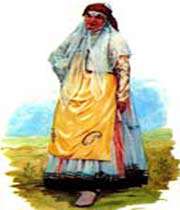Traditional Iranian Dress (Part 1)
Iran is a vast country containing many different ethnicities and languages. As a result, the traditional dress tends to vary by region, territory and sometimes even individual village. By in large, the majority of the ethnicities pertaining to the regions of Iran have traditional costumes. These include dress styles for Bakhtiaris, Baluchis, Loris, Gilanis, Kurds, Ghoochanis, Ghashghahis, and others. Some dresses come also from the different historical times, such as the Qajar dynasty. We have reviewed a few of the traditional Iranian dresses here.
The traditional Bakhtiari dress
The traditional Bakhtiari dress for women consists of a long colorful skirt with many layers, and an additional apron-like material, which is thinner and brighter. Bakhtiari women wear long scarves and wraps which can contain ornaments and decorations sewn in from faux coins to hand-sewn designs. Separate shirts are worn at the top with matching vests or shawls.
Bakhtiari clothes are versatile and protect the people from weather and extreme conditions.
Another form of the Bakhtiari dress is shown below on this 1974, two rial stamp. The stamp collection was issued to commemorate traditional Iranian clothes.
The traditional Baluchi dress
Following in similar suit, the Baluchi dress also uses bright and colorful materials. The emphasis in this style is more on the overall garment which is similar to a loose fitting dress. Underneath the dress, which falls only below the knee, women tend to wear trousers. The trousers are generally straight and long and made from cotton or easy-fitting materials.
As this is traditional Baluchi outfit is worn in the villages where manual labor is common, it is important that the dress is highly mobile and comfortable.
A small head covering may be worn with gold or silver ornaments landing gently on the forehead. The head dress is also accompanied by a larger shawl.
The Baluchi men also wear long tunics with matching color pants. Sometimes hats are worn to protect against bad weather. A sample Baluchi outfit with the traditional Baluchi hat is shown below. The two Baluchi musicians are wearing traditional white Baluchi outfits.
The traditional Ghashghahi dress
Another form of traditional dress stems from the Ghashghahi or Ghashghai region. Women from this region wear, located in the south of Iran, wear long skirts which are slightly more layered and offer much brighter colors. This can be seen below. The shirts are usually lighter in color and are sometimes entirely covered by the scarves worn on the head. The Ghashghai head cover tends to be tightly closed at the bottom of the chin with some sort of pin, for example a safety pin. A second headband-like cloth may be wrapped around the head of the individual. This cloth may be longer and hang from the person’s head back over the shoulder. Smaller ornaments such as coins may be hung from the forehead, depending on the occasion. For men, the Ghashghahi hat is a common item. The Ghashghahi hat is famous and has a very recognizable round shape, usually made from sheep’s hair. They tend to be be light brown and very soft to the touch. Another version of the Ghashgahi dress is depicted in this 1974 stamp below.

The traditional Ghoochani dress
Another form of dress, known as the Ghoochani comes from the region of Ghoochan. This region is also spelled Quochan and lies about 150 kilometers from the city of Mashhad. In the year 1791 AD, Nader Shah was killed in "Tapeh Nader" (Nader’s hill) close to the main city.
With hot summers and cold winters, the clothing in this area has to be multi-functional and versatile.
The traditional Ghoochani dress looks as depicted in the photo below. Women’s skirts tend to be shorter and the shoes tend to be made for long walks, and climbs. Vests and head covers are also common and lots of bright colors and lines are used in the patterns of the garments throughout.
Source: persianmirror.com
To be continued...
Other links:
Nowruz
Nowruz Etymology
Nowruz and the spring equinox
Nowruz tradition and mythology
Nowruz History